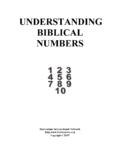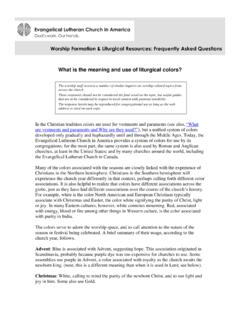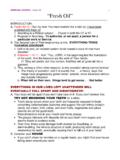Transcription of SYMBOLISM OF THE WINDING STAIRCASE - Kamloops …
1 SYMBOLISM OF THE WINDING STAIRCASE This Short Term Bulletin is reprinted from an an article in the Transactions, Texas Lodge of Research, Volume XXXV, titled The WINDING STAIRCASE . Reprinted CANMAS 1st June, 2006. Freemasonry is purported to be a beautiful system of morality, veiled in allegory and illustrated by symbols. One of the prominent allegorical symbols in Masonry is the WINDING STAIRCASE . It is the main symbol of the second or Fellowcraft Degree and is meant to be a replica of the STAIRCASE found in King Solomon's Temple. King Solomon's Temple was the House of God. The only reason for entering into it was to come into His presence. Even though it was destroyed, the Temple has long fascinated biblical scholars and architects. The exact location of the WINDING STAIRCASE within King Solomon's Temple is not well settled. Our Volume of the Sacred Law states: "The door for the middle chamber was in the right side of the house; and they went up with WINDING stairs into the middle chamber, and out of the middle into the third.
2 " Members of the Craft labored faithfully in the mountains and quarries for six days. After proving themselves worthy by paying strict fidelity and attention to their labors, they were invested with certain mysterious signs, tokens and words. The craftsmen passed through an outer porch, ascended the WINDING stairs and passed through an outer and inner door to the middle chamber. The mysterious signs, tokens and words allowed them to pass the guards or, in some accounts, the Junior Warden. After gaining admission to the middle chamber the craftsmen gathered there to receive their wages. In Masonry it is taught that the WINDING STAIRCASE , or "Sacred Stairs" located in King Solomon's Temple led from the main floor to the middle chamber, where the fellows of the craft were paid their wages. In Masonic tradition we are taught that the only way to enter the Middle Chamber is to pass through an outer porch, between two pillars, and up a flight of WINDING stairs to reach the altar located in the middle chamber.
3 The WINDING stairs to the middle chamber in the original Temple went off to the South, from just inside the porch and led toward the West. Masonic Lodges are oriented on a symbolic east-west axis consistent with that of the Temple, which was patterned after the tabernacle in the wilderness originally erected by Moses. This orientation places the entrance in the symbolic West. In Masonic Lodges today the WINDING STAIRCASE leads toward the pedestal in the East and thus must start form the North toward the South to be in a relative position. The WINDING STAIRCASE forms an important part of the Second or Fellowcraft Degree. The WINDING STAIRCASE is divided into three sections. Each section and each step within each section has a different lesson. Each individual step has a special significance and a special meaning attached to it. As Masonry is progressive, the Fellowcraft degree is a continuation of the Entered Apprentice degree.
4 It extends the plan of knowledge commenced in the first degree; it comprehends a more extensive system of learning, and inculcates, in our peculiar method, the most important truths of science. Much of the SYMBOLISM of Masonry, including the WINDING STAIRCASE , is patterned after a book by Danduras, a bishop who died in 1296. Danduras wrote that the: " WINDING staircases , imitated from Solomon's Temple, which wind among the walls and point out the hidden knowledge which they only have who ascend to celestial things. The Faithful are the stone in the wall structure. All the stones are polished and squared, that is holy and pure, and are built by the hands of Great Workman into an abiding place in the church. Again, in the Temple of God, the foundation is Faith, which is conversant with unseen things; the roof is charity, which covereth a multitude of sins.
5 The door is obedience .. The pavement is humility, of which the Psalmist saith, 'My Soul cleaveth to the pavement.' The four sides, walls, are the four cardinal virtues - justice, fortitude, temperance, prudence. Hence the Apocalypse saith, 'The City lieth four-squared.' Life is said to be divided into the three stages of youth, manhood and old age. In Masonic teaching, the WINDING STAIRCASE denotes these states of life and is similarly divided into three sections, comprised of a series of three, five and seven steps. The numbers three, five and seven have special significance in Masonry. The numbers are also said to refer to the three steps alluding to the three principal stages of human life: youth, manhood and old age. The first section has three steps. This section, denoting youth, teaches preliminary lessons and lays the foundation upon which a Mason lays his moral and Masonic edifice.
6 The Second section, comprised of five steps, denotes manhood. It builds on the foundation laid in the previous section. The steps represent the five orders of architecture. These five steps also have special reference to the human senses. The first three of these senses are held in highest esteem among Masons. They are said to make up the three component parts of a complete man (mental, physical and spiritual) which are represented by three columns. These columns are the supports of both man and Lodge. These columns denote wisdom (to contrive - mental), strength (to support - physical) and beauty (to adorn - spiritual). Ascending these five steps is to ascend beyond the five senses. When our trust is in God, our faith is well founded. With spiritual guidance, one need not rely on the material guidance of the five senses. As we ascend from five to seven steps, we ascend above the material to the mental plane. The third section is made up of seven steps and represents the ascension from manhood to old age.
7 The steps continue the building of the individual Mason's education and refer to the seven liberal arts and sciences. These are, in ascending order on the STAIRCASE : grammar, rhetoric, logic, arithmetic, geometry, music and astronomy. Of these, Masonry regards geometry as the most noble, and "is the basis on which the superstructure of Freemasonry is erected." The journey to the Middle Chamber, like so many other teachings in Freemasonry, is based upon one of the legends connected with the building of King Solomon's Temple. The Fellwocraft Mason, symbolically advancing from youth into manhood, is to receive his intellectual education. The WINDING STAIRCASE may mean different things to each individual Fellowcraft. However, the several steps symbolize the slow, arduous task of building the edifice of a Mason's character, the development of his self-discipline and his movement closer to God. In addition to their instruction in natural, mathematical and metaphysical science, the steps of The WINDING STAIRCASE , like all Masonic symbols are illustrations of discipline and doctrine.
8 The WINDING STAIRCASE invites the Fellowcraft to commence his Masonic labour by ascending the stairs. There he will receive discipline and instruction. He must begin his difficult ascent and research, which in the end gives him Divine Truth. To obtain his own self-improvement, a man must not stand still in life to become worthy of his vocation or his destiny. The WINDING STAIRCASE provides a portion of the Masonic building known as "Character" ultimately to ascend to the Sanctum Sanctorum in which our souls find rest. To climb the WINDING stairs implies "Faith." Thus a Fellowcraft Mason represents a man starting forth on his journey of life, with the great task before him of self-improvement. Faithful performance of his task will give reward to the development of all his intellectual faculties, moral and spiritual elevation of his character, as well as the acquisition of truth and knowledge. The WINDING STAIRCASE is a symbol of the growth of mental and spiritual life, of learning, study and enlarging horizons, and is a symbol of courage of Masonic character.
9 Throughout his journey, a Mason contemplates all he receives and continues onward up the WINDING STAIRCASE , not knowing what is around the next turn. Because he is a man, a Mason must climb to receive his wages. His lifelong journey is climbing upward and onward to the Middle chamber. It is at this point, after he has matured and has reached Masonic old age, he earns the reward and learns that Truth consists of a perfect knowledge of the Great Architect of the Universe. The WINDING STAIRCASE denotes the necessity for a courageous ascent. Because of its WINDING the stairs do not disclose what is ahead. One must face the unknown in life with courage. The Fellowcraft Degree, as whole, is a symbol of manhood, and the WINDING STAIRCASE denotes the courage needed for manhood. Masonic writer Carl F. Claudy tells us: "It requires more courage to face the unknown than the known. A straight stair, a ladder, hides neither secret nor mystery at its top.
10 But the stairs which wind hide each step from the climber; what is just around the corner is unknown. The WINDING stairs of life lead us to we know not what; for some of us a Middle Chamber of fame and fortune; for others, one of pain and frustration. The Angel of Death may stand with drawn sword on the very next step for any of us. Yet man climbs." The WINDING STAIRCASE has been used to describe a level of psychological consciousness relating to the body, soul and spirit. It is considered among the most complicated of the Craft's symbols as they define various levels of consciousness, form consciousness of the physical body at the bottom to that of the spirit and divinity at the top. Thus, as one ascends the stairs and passes through the Veil and sees the Sacred Symbol of the Middle Chamber, he will understand that the end of all human endeavour is to reach the Divine. This ascent by a WINDING STAIRCASE to the place where the wages of labour are to be received has also been described as an allegory to teach us the ascent of the mind from ignorance to knowledge and form darkness to light.









